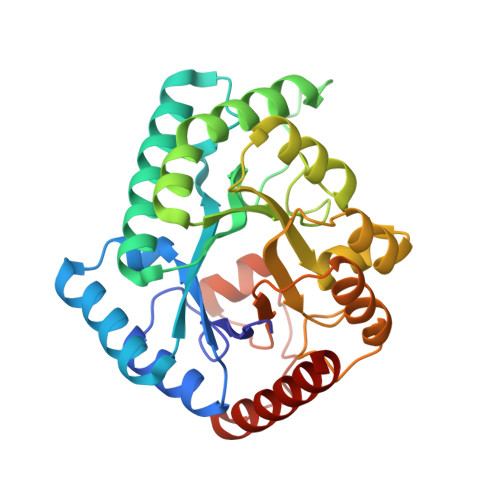Crystal structures of D-tagatose 3-epimerase from Pseudomonas cichorii and its complexes with D-tagatose and D-fructose
Yoshida, H., Yamada, M., Nishitani, T., Takada, G., Izumori, K., Kamitori, S.(2007) J Mol Biology 374: 443-453
- PubMed: 17936787
- DOI: https://doi.org/10.1016/j.jmb.2007.09.033
- Primary Citation of Related Structures:
2OU4, 2QUL, 2QUM, 2QUN - PubMed Abstract:
Pseudomonas cichoriiid-tagatose 3-epimerase (P. cichoriid-TE) can efficiently catalyze the epimerization of not only d-tagatose to d-sorbose, but also d-fructose to d-psicose, and is used for the production of d-psicose from d-fructose. The crystal structures of P. cichoriid-TE alone and in complexes with d-tagatose and d-fructose were determined at resolutions of 1.79, 2.28, and 2.06 A, respectively. A subunit of P. cichoriid-TE adopts a (beta/alpha)(8) barrel structure, and a metal ion (Mn(2+)) found in the active site is coordinated by Glu152, Asp185, His211, and Glu246 at the end of the beta-barrel. P. cichoriid-TE forms a stable dimer to give a favorable accessible surface for substrate binding on the front side of the dimer. The simulated omit map indicates that O2 and O3 of d-tagatose and/or d-fructose coordinate Mn(2+), and that C3-O3 is located between carboxyl groups of Glu152 and Glu246, supporting the previously proposed mechanism of deprotonation/protonation at C3 by two Glu residues. Although the electron density is poor at the 4-, 5-, and 6-positions of the substrates, substrate-enzyme interactions can be deduced from the significant electron density at O6. The O6 possibly interacts with Cys66 via hydrogen bonding, whereas O4 and O5 in d-tagatose and O4 in d-fructose do not undergo hydrogen bonding to the enzyme and are in a hydrophobic environment created by Phe7, Trp15, Trp113, and Phe248. Due to the lack of specific interactions between the enzyme and its substrates at the 4- and 5-positions, P. cichoriid-TE loosely recognizes substrates in this region, allowing it to efficiently catalyze the epimerization of d-tagatose and d-fructose (C4 epimer of d-tagatose) as well. Furthermore, a C3-O3 proton-exchange mechanism for P. cichoriid-TE is suggested by X-ray structural analysis, providing a clear explanation for the regulation of the ionization state of Glu152 and Glu246.
- Life Science Research Center and Faculty of Medicine, Kagawa University, 1750-1 Ikenobe, Miki-cho, Kita-gun, Kagawa 761-0793, Japan.
Organizational Affiliation:


















